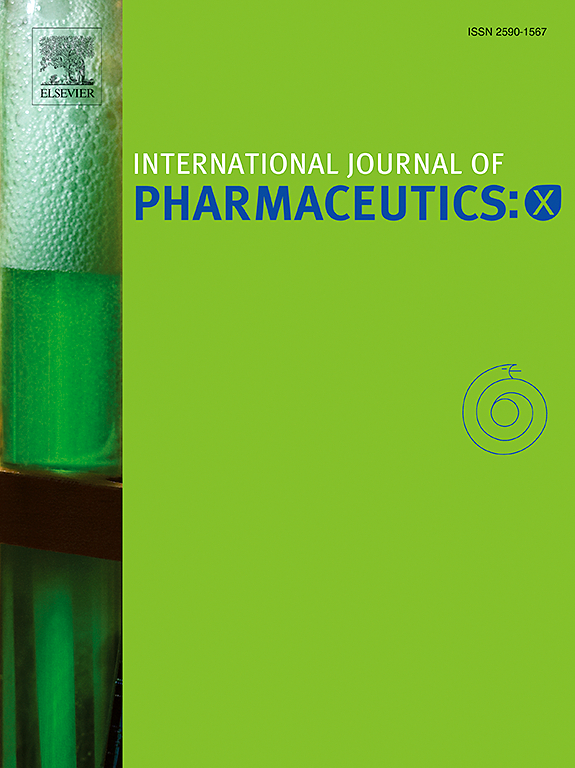HSPiP and QbD oriented optimized nanocubosomes for ameliorated absorption of tolterodine tartrate: In vitro and in vivo evaluations
IF 6.4
2区 医学
Q1 PHARMACOLOGY & PHARMACY
引用次数: 0
Abstract
The study explored HSPiP and QbD-(quality by design) enabled optimized cubosomes for sustained drug release, improved permeation, and enhanced oral bioavailability. OCUB1 (the optimized product) was characterized for size, zeta potential (ZP), thermal analysis, and surface roughness. In vitro drug release and hemolysis studies were carried out using a dialysis membrane and rat erythrocytes (4 % suspension), respectively. An ex vivo non-everted intestinal permeation study (180 min) compared permeation potential between DS (suspension) and OCUB1. In vivo pharmacokinetic (PK) study investigated PK parameters in rats whereas hematological and biochemical assays ensured the safety of OCUB1. HSPiP predicted glyceryl monooleate (GMO), poloxamer−188, and polyvinyl alcohol (PVA) as optimal excipients based on minimum RED (relative energy difference) values while QbD identified OCUB1 as the most optimized formulation with desirable attributes such as low size (169 nm), high ZP (−29.2 mV), low polydispersity index (0.23), and maximum entrapment efficiency (85.3 %). Thermal analysis confirmed solubilization of TOTA in OCUB1, and atomic force microscopy (AFM) technique confirmed its cubical shape. OCUB1 showed extended drug release (98.1 % over 48 h) and sustained ex vivo permeation (Jss = 6.69 μg/cm2/min, steady state flux) across rat intestine as compared to DS (Jss = 9.172 μg/cm2/min). In vivo PK parameters exhibited significant improvement, with 3.2-fold increase in Cmax as compared to the DS. In vitro hemolysis, along with biochemical and hematological assays, ensured the safety of OCUB1 for oral delivery. Conclusively, OCUB1 presents a promised alternative to conventional capsule, offering reduced side effects and enhanced patient compliance.

面向HSPiP和QbD的优化纳米糖体改善酒石酸托特罗定的吸收:体外和体内评价
该研究探索了HSPiP和QbD-(质量设计)使优化的立方体体能够持续释放药物,改善渗透,提高口服生物利用度。对OCUB1(优化产物)进行了尺寸、zeta电位(ZP)、热分析和表面粗糙度的表征。体外药物释放和溶血研究分别使用透析膜和大鼠红细胞(4%悬液)进行。一项体外非膨化肠渗透研究(180分钟)比较了DS(混悬液)和OCUB1的渗透电位。体内药代动力学(PK)研究了大鼠体内药代动力学参数,血液学和生化实验证实了OCUB1的安全性。基于最小RED(相对能差)值,HSPiP预测单油酸甘油酯(GMO)、poloxomer - 188和聚乙烯醇(PVA)为最佳辅料;QbD认为OCUB1为最佳辅料,具有低尺寸(169 nm)、高ZP (- 29.2 mV)、低多分散指数(0.23)和最高包封效率(85.3%)等理想属性。热分析证实TOTA在OCUB1中有增溶作用,原子力显微镜(AFM)技术证实其呈立方体形状。与DS (Jss = 9.172 μg/cm2/min)相比,OCUB1在大鼠肠内具有较长的释药时间(48 h内释药98.1%)和持续的体外渗透(Jss = 6.69 μg/cm2/min,稳态通量)。体内PK参数显著改善,Cmax较DS提高3.2倍。体外溶血以及生化和血液学检测,保证了OCUB1口服给药的安全性。最后,OCUB1提供了传统胶囊的替代方案,减少了副作用,提高了患者的依从性。
本文章由计算机程序翻译,如有差异,请以英文原文为准。
求助全文
约1分钟内获得全文
求助全文
来源期刊

International Journal of Pharmaceutics: X
Pharmacology, Toxicology and Pharmaceutics-Pharmaceutical Science
CiteScore
6.60
自引率
0.00%
发文量
32
审稿时长
24 days
期刊介绍:
International Journal of Pharmaceutics: X offers authors with high-quality research who want to publish in a gold open access journal the opportunity to make their work immediately, permanently, and freely accessible.
International Journal of Pharmaceutics: X authors will pay an article publishing charge (APC), have a choice of license options, and retain copyright. Please check the APC here. The journal is indexed in SCOPUS, PUBMED, PMC and DOAJ.
The International Journal of Pharmaceutics is the second most cited journal in the "Pharmacy & Pharmacology" category out of 358 journals, being the true home for pharmaceutical scientists concerned with the physical, chemical and biological properties of devices and delivery systems for drugs, vaccines and biologicals, including their design, manufacture and evaluation. This includes evaluation of the properties of drugs, excipients such as surfactants and polymers and novel materials. The journal has special sections on pharmaceutical nanotechnology and personalized medicines, and publishes research papers, reviews, commentaries and letters to the editor as well as special issues.
 求助内容:
求助内容: 应助结果提醒方式:
应助结果提醒方式:


